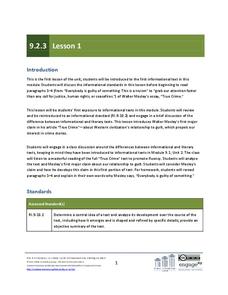Curated and Reviewed by
Lesson Planet
This Grade 9 ELA Module 2, Unit 3, Lesson 1 lesson plan also includes:
- EngageNY Resources (.html)
- Grade 9 ELA Module 2, Unit 3, Lesson 1 (.docx)
- Grade 9 ELA Module 2 Unit 3 Overview (.pdf)
- Grade 9 ELA Module 2 Unit 3 Overview (.docx)
- Grade 9 ELA Module 2 Overview (.pdf)
- Grade 9 ELA Module 2 Overview (.docx)
- Grade 9 ELA Module 2 Performance Assessment (.pdf)
- Grade 9 ELA Module 2 Performance Assessment (.docx)
- Grade 9 ELA Curriculum Map (.pdf)
- Grade 9 ELA Curriculum Map (.docx)
- Join to access all included materials
"True-crime stories, murder mysteries, up-to-the-minute online news reports, and (as always) rumor and innuendo grab our attention faster than any call for justice, human rights, or ceasefires." Or so says Walter Mosley in his Newsweek essay, "True Crime." As an introduction to informational text, class members briefly note the differences between informational and literary texts and then examine Mosley's claims and the evidence he uses to support them.
37 Views
8 Downloads
CCSS:
Designed
Concepts
Additional Tags
Instructional Ideas
- Have a class member prepare a masterful reading of the full "True Crime" article
- Use the Quick Write as an exit ticket
Classroom Considerations
- The 13-lesson unit, the third in a module of three, not only builds on the protocols and routines established in the first two units but also presumes class members have read the anchor text for those units: Poe’s “The Tell-Tale Heart,” Emily Dickinson’s “I Felt a Funeral, in my Brain,” and Sophocles’ Oedipus the King
- The three texts that anchor the unit are: “True Crime: The Roots of an American Obsession," “How Bernard Madoff Did It,” and excerpts from The Wizard of Lies
- The unit, entitled “Everybody is Guilty of Something,” examines the treatment of guilt and people’s fascination with crime.
- Each lesson in the unit addresses specific Common Core standards
- A link to Mosley's article is provided on page eight of the full module found in the Included Materials section below
Pros
- The 10-page packet includes a list of the Common Core standards addressed by the lesson, a vocabulary list, discussion questions with model responses, a writing prompt, and a rubric
Cons
- None



